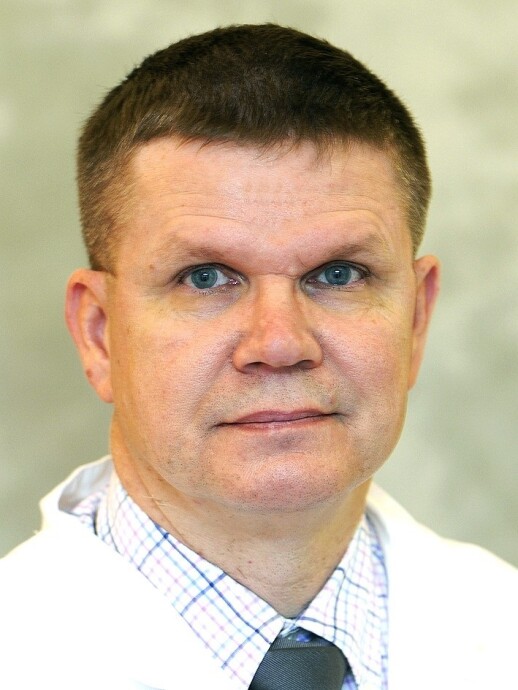
Links
Areas of expertise
Biography
Degrees and competences
- Licentiate of Medicine, University of Helsinki 18 Jan 1983
- M.Sc. (Diplomi-insinööri) Helsinki University of Technology, Department
- of Technical Physics 29 Nov 1988
- Doctor of Medical Sciences, University of Helsinki 8 Jun 1990
- Specialist in Radiology 26 Mar 1991
- Subspecialist in Medical Administration 3 Dec 2002
- Docent in Radiology, University of Helsinki 28 Dec 1995
- Docent in Functional Medical Imaging, Helsinki Univ. of Technology 1 Mar 1998
Current Tasks
- Professor and Chair of Radiology, University of Turku, Finland 1 Apr 2006
- Chief Radiologist (Ylilääkäri), Turku University Hospital 1 Jan 2009
Previous tasks
- Post Doctoral Researche (35 months), Harvard Medical School, Massachusetts General Hospital, NMR Center, Boston, MA, USA, 1990-93
- The University in Helsinki, Assistant Professor of Radiology 1993-1996
- The University of Kuopio, Assosiate Professor of Radiology 1997-1998
- The University of Kuopio, Professor of Radioloty 1998-2002
- Leader of research group “Functional Brain Imaging Unit”, which was one of the six groups forming the Helsinki Brain Research Centre, a Centre of Excellence funded by the Academy of Finland and headed by Professor Risto Näätänen. 2002-2007
Research
In the mid-1980s I began to study magnetic resonance flow phenomena using an experimental flow phantom. With the help of a Fogarty grant from the NIH, I began MRI perfusion and diffusion work under the supervision of Professors Bruce Rosen and Thomas Brady and in collaboration with the late Associate Professor John Belliveau at the Harvard Medical School-Massachusetts General Hospital NMR Center. We made two important scientific findings: high cerebral blood volume evaluated by MRI CBV imaging is strongly associated with the grade of human gliomas (Aronen et al. Radiology 1994) and high cerebral blood volume is associated with high glucose uptake evaluated by means of PET FDG studies, indicating an association of capillary density and energy metabolism in human gliomas (Aronen et al. Clinical Cancer Research 2000).
I continued my collaboration with the MGH NMR Center,particularly with Associate Professor Belliveau until he passed February 14, 2014. Upon returning to Finland in 1993 I immediately started my own research group, beginning in Helsinki, then in 1997 in Kuopio and since 2007 also in Turku. We demonstrated the usefulness of magnetization transfer and spin locking techniques in the characterization of head and neck tumors (Radiology 1996;200:369-375). We also evaluated MR imaging in the diagnosis of pelvic inflammatory disease (Radiology 1999;210:209-216) and MR imaging of Achilles tendon problems (AJR 1999;173:323-328, AJR 2000;175:251-260). We were able to demonstrate the usefulness of combined perfusion and diffusion MR imaging in acute (Stroke 1999;30:1583-1590 and Radiology 2000;217:886-894) and hyperacute (Stroke 2005;36:44-49) stroke patients. We have addressed the potential of perfusion MRI studies in the evaluation of coronary artery disease patients (Circulation 1997;96:2859-2867) and myocardial viability (Radiology 2000;217:729-736). One important direction of our research has been the comparison and combination of MEG and fMRI studies (Hum Brain Map 1999;8:13-27, Radiology 2006;241:213-22). My research group has contributed to the methodological development and evaluation of susceptibility contrast perfusion (Mag Reson Med 2002;47:973-981) together with Professor Leif Østergaard (Århus University Hospital). We have developed and evaluated effective fMRI analysis methods based on contextual clustering (IEEE T Med Imaging 2001;20:403-414 and NeuroImage 2001;13:459-471) and permutation (NeuroImage 2006;32:654-664).
Together with Professor Synnöve Carlson we have imaged the primarily frontoparietal network active during the visuospatial (Cerebral Cortex 1998;8:743-752) and audiospatial (Cerebral Cortex 2000;10:889-898) working memory tasks. During the years 2002-2007 my research group “Functional Brain Imaging Unit” was one of the six groups forming the Helsinki Brain Research Centre, a Centre of Excellence funded by the Academy of Finland and headed by Professor Risto Näätänen. A recent focus of my research has been the MR imaging of prostate cancer. A part of the project is being carried out in collaboration with the Turku PET Centre (J Nucl Med 2010;51:1676-83, Eur J Radiol. 2012 Nov;81(11):2966-72, Acta Oncol 2016;55:59-67). We performed more than 800 research prostate MRI scans since 2010. We have finalized two prospective registered clinical trials in Turku. (JMRI 2015;41:1116-1124, JMRI 2017;46:1089-1095) and published 17 original articles on the subject. In our studies a short MRI protocol consisting of T2-weighted and diffusion weighted imaging was shown to be a very accurate tool for the detection and characterization of clinically significant prostate cancer. Utilizing our preliminary version of algorithms based on machine learning we have been able to develop semiautomatic methods for the analysis of prostate cancer MRI data sets.